340 9th Street North
Suite 86, Naples FL 34102
[email protected]
239.354.3361


Find an SBS Equine Dealer or Distributor:
>> US Dealer List
>> International Dealer List
>> Distributor List
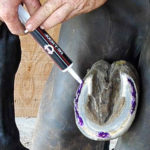
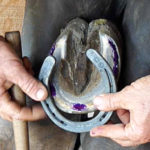 The most recent guidelines on disinfection from the Centers for Disease Control and Prevention report that many deeply rooted infections contain spores. They are a major health issue because bacterial and fungal spores are so difficult to eradicate. The CDC guidelines indicate that low strength disinfection can be effective in reducing bacteria and fungi on relatively smooth surfaces with a contact time of 30 seconds, but not for spores! Apparently the deeper the infection in organic and inorganic material, the more difficult it is to kill spores. Strong liquid preparations that can kill spores within 30 seconds near top surfaces are not as effective for deeply seated spores. New CDC guidelines recommend that high strength disinfectants need a contact time of 12 minutes or more to kill deeply rooted spores; however, they caution that some spores may still remain after 12 minutes. To help increase treatment contact times and improve results, hoof researchers are embracing medical gel technology. Dr. Richard Shakalis and Dr. John Pautienis developed a powerful gel formula over two decades ago that is still recognized as a leading commercial preparation against chronic thrush and white line disease. It is no secret that the formula’s enduring success has been its ability to stop deeply rooted bacteria and fungal spores in hooves. The mechanism works by bonding to hoof protein which promotes a longer contact time with diseased deep tissue than with traditional liquid preparations. Hoof researchers worldwide now recognize that contact time and formula strength are key elements to fighting these chronic conditions that are so difficult to treat.
The most recent guidelines on disinfection from the Centers for Disease Control and Prevention report that many deeply rooted infections contain spores. They are a major health issue because bacterial and fungal spores are so difficult to eradicate. The CDC guidelines indicate that low strength disinfection can be effective in reducing bacteria and fungi on relatively smooth surfaces with a contact time of 30 seconds, but not for spores! Apparently the deeper the infection in organic and inorganic material, the more difficult it is to kill spores. Strong liquid preparations that can kill spores within 30 seconds near top surfaces are not as effective for deeply seated spores. New CDC guidelines recommend that high strength disinfectants need a contact time of 12 minutes or more to kill deeply rooted spores; however, they caution that some spores may still remain after 12 minutes. To help increase treatment contact times and improve results, hoof researchers are embracing medical gel technology. Dr. Richard Shakalis and Dr. John Pautienis developed a powerful gel formula over two decades ago that is still recognized as a leading commercial preparation against chronic thrush and white line disease. It is no secret that the formula’s enduring success has been its ability to stop deeply rooted bacteria and fungal spores in hooves. The mechanism works by bonding to hoof protein which promotes a longer contact time with diseased deep tissue than with traditional liquid preparations. Hoof researchers worldwide now recognize that contact time and formula strength are key elements to fighting these chronic conditions that are so difficult to treat.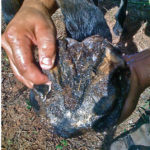 impossible to eliminate with one application of a strong liquid topical agent without harming the surrounding healthy tissue. In order to achieve longer contact times to reach these deeply seated spores, horse owners have resorted to soaking hooves with liquid preparations. Soaking hooves with liquid preparations with the aid of a soaking boot, bag or bucket can improve their contact time, but not without potential consequences…over-soaking with caustic ingredients can damage hoof tissue permanently… administering soaking preparations daily is labor intensive and expensive… disposal of soaking solutions after use can be bad for the environment.
impossible to eliminate with one application of a strong liquid topical agent without harming the surrounding healthy tissue. In order to achieve longer contact times to reach these deeply seated spores, horse owners have resorted to soaking hooves with liquid preparations. Soaking hooves with liquid preparations with the aid of a soaking boot, bag or bucket can improve their contact time, but not without potential consequences…over-soaking with caustic ingredients can damage hoof tissue permanently… administering soaking preparations daily is labor intensive and expensive… disposal of soaking solutions after use can be bad for the environment.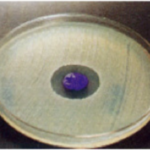 Hospital laboratory analysis has confirmed that medical gels work well at controlling the spread of bacteria and fungi without harming surrounding tissue. In field studies initiated by Drs. Shakalis & Pauteinis, diseased specimens were removed deep from within the hoof wall of horses with confirmed cases of white line disease and placed in sterile culture containers. Then these samples were sent to laboratory technicians for extensive analysis. The agar plate shows examples of bacteria growing on the entire plate, except in the darker, clear area surrounding the sample of the blue medical gel in the center. This area is bacteria free and represents the very effective kill zone offered by the medical gel. Bacteria was unable to grow and survive in this kill zone. The medical gel provided for the analysis was Sav-A-Hoof Gel.
Hospital laboratory analysis has confirmed that medical gels work well at controlling the spread of bacteria and fungi without harming surrounding tissue. In field studies initiated by Drs. Shakalis & Pauteinis, diseased specimens were removed deep from within the hoof wall of horses with confirmed cases of white line disease and placed in sterile culture containers. Then these samples were sent to laboratory technicians for extensive analysis. The agar plate shows examples of bacteria growing on the entire plate, except in the darker, clear area surrounding the sample of the blue medical gel in the center. This area is bacteria free and represents the very effective kill zone offered by the medical gel. Bacteria was unable to grow and survive in this kill zone. The medical gel provided for the analysis was Sav-A-Hoof Gel.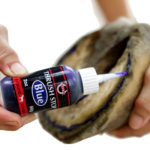 over 70 countries and have been on the market for over two decades. Manufacturers of hoof care products are actively incorporating medical gels into their new product development programs. The reasons are simple: medical gels offer many benefits that may be lacking in liquid preparations. For example, medical gel formulas are sticky and bond nicely to hoof tissue…medical gels have complex, time-release formulas which allow key ingredients to absorb into the affected tissue more uniformly and over an extended time period, sometimes lasting several hours or even days…gel formulas can improve end results by increasing contact time against affected tissue by 10x more than liquids, without harming the surrounding healthy tissue… there is less mess and environmental waste with gels than liquid formulas resulting in a potential savings of 50% or more…long neck tips of applicator caps can dispense gel ingredients with more control, which saves time and money! Most liquid preparations have an effective contact time of 10 to 30 seconds before running off or evaporating. Longer contact times can harm healthy hoof tissue.
over 70 countries and have been on the market for over two decades. Manufacturers of hoof care products are actively incorporating medical gels into their new product development programs. The reasons are simple: medical gels offer many benefits that may be lacking in liquid preparations. For example, medical gel formulas are sticky and bond nicely to hoof tissue…medical gels have complex, time-release formulas which allow key ingredients to absorb into the affected tissue more uniformly and over an extended time period, sometimes lasting several hours or even days…gel formulas can improve end results by increasing contact time against affected tissue by 10x more than liquids, without harming the surrounding healthy tissue… there is less mess and environmental waste with gels than liquid formulas resulting in a potential savings of 50% or more…long neck tips of applicator caps can dispense gel ingredients with more control, which saves time and money! Most liquid preparations have an effective contact time of 10 to 30 seconds before running off or evaporating. Longer contact times can harm healthy hoof tissue.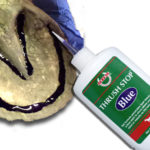 Some of the medical gel formulas are designed to stain diseased hoof tissue a dark blue color. This feature shows horse handlers where to add more gel as the blue color fades. Medical gel products are formulated to fight stubborn bacteria & fungi along white line, clefts of the frog, cracks and nail holes. The use of narrow flexible tips by manufacturers are designed to help control gel placement so there is less waste and run-off to the environment. Stronger medical gel formulas are frequently applied with syringe applicators or oval squeeze bottles with long neck caps. The stronger medical gel formulations are more effective at fighting deeply rooted conditions of white line disease and chronic thrush. Time-releasing medical gels can last for days when applied between horseshoes and the white line. Medical gels sticks to the hoof protein and offer long lasting protection. Professionals recommend cleaning, picking & brushing hooves before applying any chemical treatment.
Some of the medical gel formulas are designed to stain diseased hoof tissue a dark blue color. This feature shows horse handlers where to add more gel as the blue color fades. Medical gel products are formulated to fight stubborn bacteria & fungi along white line, clefts of the frog, cracks and nail holes. The use of narrow flexible tips by manufacturers are designed to help control gel placement so there is less waste and run-off to the environment. Stronger medical gel formulas are frequently applied with syringe applicators or oval squeeze bottles with long neck caps. The stronger medical gel formulations are more effective at fighting deeply rooted conditions of white line disease and chronic thrush. Time-releasing medical gels can last for days when applied between horseshoes and the white line. Medical gels sticks to the hoof protein and offer long lasting protection. Professionals recommend cleaning, picking & brushing hooves before applying any chemical treatment. 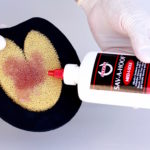 designed specifically for use under shoes and pads. Wool, leather, and synthetic pads are sometimes pre-treated with medical gels. Additional gel can be added by horse handlers as needed, through the gap at the heels between the sole and pad. Many farriers make their own custom hoof packing by saturating open-cell foam scraps. Gel formulas can lasts for hours and do not run off or make a mess like liquid preparations for this type of application.
designed specifically for use under shoes and pads. Wool, leather, and synthetic pads are sometimes pre-treated with medical gels. Additional gel can be added by horse handlers as needed, through the gap at the heels between the sole and pad. Many farriers make their own custom hoof packing by saturating open-cell foam scraps. Gel formulas can lasts for hours and do not run off or make a mess like liquid preparations for this type of application. 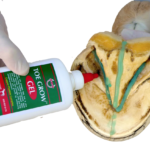 sealing in contaminants. circulation and promote faster healing and cell growth…they work by attaching to receptors in cells that signal the brain to heal cell damaged tissue. The technology was discovered during animal experiments using horses in the early 1990’s by Dr Loren Pickart. His work led to the discovery of copper-peptide’s amazing benefits at repairing cell damage for humans. The rapid improvement in the hoof condition of horses was observed during the animal studies.
sealing in contaminants. circulation and promote faster healing and cell growth…they work by attaching to receptors in cells that signal the brain to heal cell damaged tissue. The technology was discovered during animal experiments using horses in the early 1990’s by Dr Loren Pickart. His work led to the discovery of copper-peptide’s amazing benefits at repairing cell damage for humans. The rapid improvement in the hoof condition of horses was observed during the animal studies.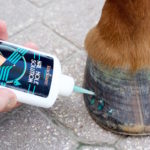 Medical gel technology offers hoof care professionals, horse owners, and their handlers simple new options for treating major hoof problems. Medical gels are highly absorptive aqueous formulas that continually release their ingredients into hoof tissue. Petroleum jelly, salves or sealants (fats) are self-contained and non-dispersible. They do not release their ingredients to surrounding tissue… shelf life is usually longer with medical gel products than liquid formulas because there is less evaporation and separation of ingredients while packaged or in storage…medical gels stick to hoof tissue longer than liquid products which improves their contact time and end results… medical gel formulas are effective at treating cell damage and a variety of pathological conditions such as white line disease, seedy toe, thrush, candida yeast, aerobic and anaerobic bacteria, mold and fungi…there is less mess and waste when applying medical gels with syringes and squeeze bottles with long tip dispensers…and medical gels improve product placement, which can save time and money, and help get the results you want.
Medical gel technology offers hoof care professionals, horse owners, and their handlers simple new options for treating major hoof problems. Medical gels are highly absorptive aqueous formulas that continually release their ingredients into hoof tissue. Petroleum jelly, salves or sealants (fats) are self-contained and non-dispersible. They do not release their ingredients to surrounding tissue… shelf life is usually longer with medical gel products than liquid formulas because there is less evaporation and separation of ingredients while packaged or in storage…medical gels stick to hoof tissue longer than liquid products which improves their contact time and end results… medical gel formulas are effective at treating cell damage and a variety of pathological conditions such as white line disease, seedy toe, thrush, candida yeast, aerobic and anaerobic bacteria, mold and fungi…there is less mess and waste when applying medical gels with syringes and squeeze bottles with long tip dispensers…and medical gels improve product placement, which can save time and money, and help get the results you want. 340 9th Street North
Suite 86, Naples FL 34102
[email protected]
239.354.3361


Find an SBS Equine Dealer or Distributor:
>> US Dealer List
>> International Dealer List
>> Distributor List